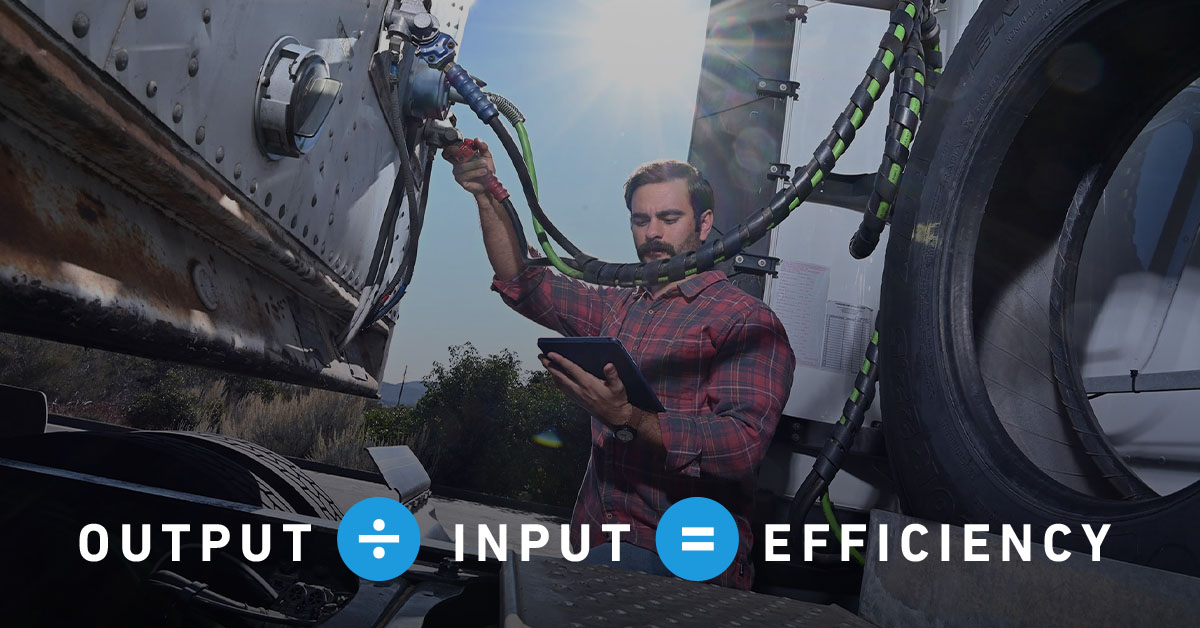How to Calculate Your Fleet’s Vehicle Inspection Efficiency Rate

Completing a driver vehicle inspection report (DVIR) is a daily task for many fleets. But there’s often an efficiency gap around these inspections that can affect your fleet’s ability to be up and running.
Here’s how you can determine what gaps exist in your DVIR process and how you can improve efficiency by digitizing your inspections.
What is the Efficiency Equation?
Efficiency is defined as a measure of energy and work. The standard measurement is to express efficiency as a ratio using this formula:

Output is the total amount of useful work completed without any waste and input is energy. You can add to this equation to express efficiency as a percentage by multiplying the ratio by 100.
This formula can help you determine effectiveness for vehicle inspections. Is a paper-based DVIR process costing too much energy to keep your vehicles well-maintained? Let’s find out.
Step 1: define your input
The input, or energy, your team expends to complete and manage DVIRs can be hard to define because so many people, from drivers to mechanics to fleet managers, are involved in vehicle inspections. Start small by quantifying these inputs and add to them as you think through each step in your inspection process. It’s often easiest to separate your inputs into categories, such as:
Soft or indirect costs:
- Driver time (e.g. hours spent) to complete DVIR paperwork pre- and post-trip
- Mechanic time to repair rather than maintain vehicles
- Manager time to review and sign off on DVIRs
- Administrative time to digitize the hard copy DVIR data
- Administrative time for “paper chasing” (tracking down missing, misplaced, late, lost paper forms)
- Manager or executive time to analyze inspection reports
Hard or direct costs:
- Vehicle downtime for repairs
- Cost of paper, printers, pens, and files
Step 2: define your output
The output, or useful work, you add to the equation must also be defined in a quantitative manner to calculate your efficiency. For example, your outputs might include:
- Number of DVIRs completed accurately and on time
- Additional vehicle uptime
- Number of strategic fleet decisions made by managers or executives using reports on inspection statuses, repair times, etc.
- Compliance success
Once you define your outputs, you can calculate your fleet’s vehicle inspection efficiency rate.
Step 3: increase DVIR efficiency
If your equation is out of balance, you must reduce your input and get greater output to increase efficiency. Revisit your inputs and outputs, this time using your ideal figures.
What would your DVIR process look like in a perfect world?
- Improved vehicle inspection workflow
- Reduced driver time spent on DVIRs
- Reduced mechanic and manager time spent on DVIRs
- Provide visual proof of defects
- Increased fleet uptime
- Easily accessible vehicle maintenance status
- Easily accessible manager and executive insights
- Improved compliance reputation
- Intuitive digital platform
- Expansive access to insights and reporting
- Customizable forms
- Easy-to-use driver and manager workflows
Step 4: digitize your DVIRs
Get to your ideal efficiency rate by moving away from paper forms and digitizing your DVIRs. Using electronic DVIRs increases the speed, user-friendliness, and effectiveness of the entire process.
- Save time with faster driver inspections, mechanic awareness, and manager tracking
- Better understand reported defects with comments, photos, and video uploads
- Improve vehicle uptimes with clearer, smoother maintenance workflows
- Save time with email notifications for a particular status, like a major defect
- Improve decision-making with better, more detailed reporting
- Stay in compliance more easily with accessible, digital data
- Save budget with less paper and printer ink
Go digital with your DVIRs
Lytx® can help you move to an electronic DVIR solution for your fleet. With a custom-built DVIR service that includes a standalone option, you can solve your maintenance problems in the same place you manage your fleet safety program.
If you want to learn more, use this checklist to determine which features a DVIR solution should have.
